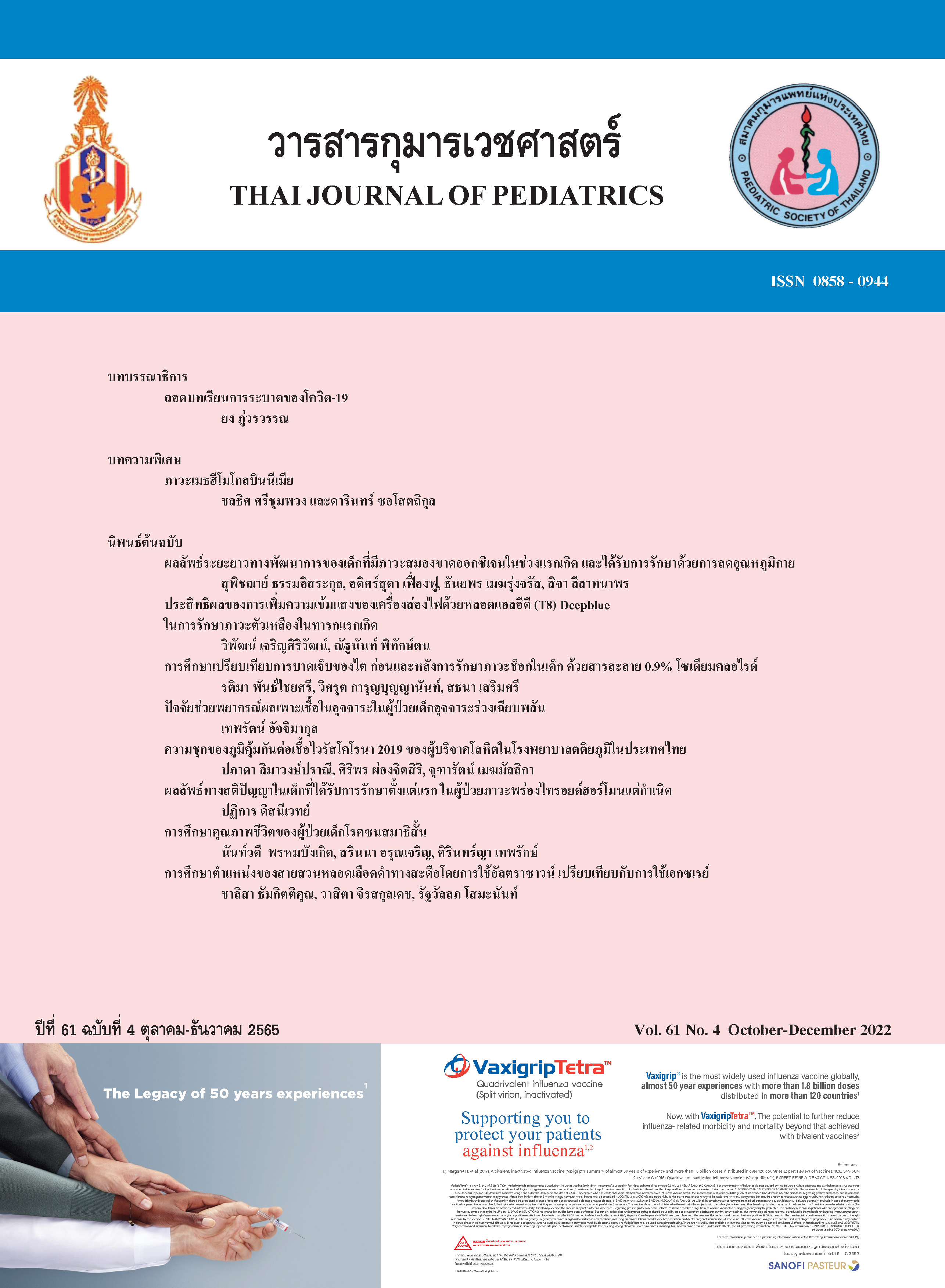การศึกษาคุณภาพชีวิตของผู้ป่วยเด็กโรคซนสมาธิสั้น
คำสำคัญ:
คุณภาพชีวิต, โรคซนสมาธิสั้นบทคัดย่อ
ความเป็นมา: โรค์ชนสมาธิสั้น (Attention-deici/hyperactivity disorder) เป็นหนึ่งในโรคเรื้อรังทางด้านพัฒนาการและพฤติกรรมที่พบบ่อยในเด็กและวัยรุ่น เกิดจากความผิดปกติของพัฒนาการทางสมองซึ่งส่งผลต่อพฤติกรรม อารมณ์ การเรียน การทำงาน หรือการเข้าสังคม นอกเหนือจากประสิทธิภาพในการรักษาโรคที่ดีแล้ว การช่วยให้ผู้ป่วยเด็กเหล่านี้มีคุณภาพชีวิตที่ดีขึ้นจึงเป็นเป้าหมายในการรักษาที่สำคัญ
วัตถุประสงค์: เพื่อศึกษาคุณภาพชีวิตของผู้ป่วยเด็กโรดชนสมาธิสั้น อายุ 6 - 15 ปี
วิธีการศึกษา: การศึกษานี้เป็นการศึกษาเชิงพรรณนาแบบตัดขวาง ผู้เข้าร่วมการศึกษา คือ ผู้ป่วยเด็กโรคซนสมาธิสั้นอายุ 6-15 ปี ที่มารับบริการในคลินิกพัฒนาการเด็ก โรงพยาบาลภูมิพลอดุลยเดช ทำการศึกษาระหว่างเดือนกรกฏาคม พ.ศ. 2562 ถึงเดือนธันวาคม พ.ศ. 2564 เก็บข้อมูลจากการตอบแบบสอบถามโดยผู้ปกครอง ได้แก่ แบบสอบถามข้อมูลส่วนบุคคลทั่วไป, Pediatric Quality of Life InventoryTM 4.0 Core Scales (PedsQL) ฉบับภาษาไทย และ Parenting Stress Index-Short Form (PSI-SF)
ผลการศึกษา: ผู้เข้าร่วมวิจัยจำนวน 110 รายคะแนนเฉลี่ยคุณภาพชีวิตโดยรวม 64.9 13.02 คะแนนเฉลี่ยคุณภาพชีวิตด้านกายภาพสูงกว่าด้านจิตสังคม ผู้ป่วยเด็กโรคซนสมาธิสั้นที่ไม่มีโรคร่วมหรือได้รับการรักษาด้วยพฤติกรรมบำบัดมีคะแนนเฉลี่ยคุณภาพชีวิตโดยรวมสูงกว่าผู้ป่วยเด็กที่มีโรคร่วมหรือได้รับการรักษาด้วยพฤติกรรมบำบัคร่วมกับยา คะแนนเฉลี่ยคุณภาพชีวิตโดยรวมของผู้ป่วยเด็กที่ผู้ปกครองอยู่ร่วมกับสามีภรรยา ไม่มีโรคทางกายสูงกว่าผู้ป่วยเด็กที่ผู้ปกครองมีปัญหาดังกล่าว ความเครียดของผู้ปกครองมีความสัมพันธ์เชิงลบกับคุณภาพชีวิตผู้ป่วยเด็กโรคซนสมาธิสั้นอย่างมีนัยสำคัญทางสถิติ
สรุป: ผู้ป่วยเด็กโรคชนสมาธิสั้นมีคุณภาพชีวิตด้านจิตสังคมด้อยกว่าด้านกายภาพ และคุณภาพชีวิตด้านโรงเรียนด้อยที่สุด ความเครียดของผู้ปกครองมีความสัมพันธ์เชิงลบกับคุณภาพชีวิตของผู้ป่วยเด็กโรคซนสมาธิสั้น การประเมินและดูแลผู้ป่วยเด็กโรคซนสมาธิสั้นและครอบครัวอย่างองค์รวม อาจส่งผลให้คุณภาพชีวิตของผู้ป่วยเด็กเหล่านี้ดีขึ้น
Downloads
เอกสารอ้างอิง
Wolraich ML, Hagan JF Jr, Allan C, et al. Clinical Practice Guideline for the Diagnosis, Evaluation, and Treatment of Attention-Deficit/Hyperactivity Disorderin Children and Adolescents. Pediatrics. 2019;144:e20192528.
Polanczyk G, de Lima MS, Horta BL, Biederman J, Rohde LA. The worldwide prevalence of ADHD a systematic review and metaregression analysis. Am J Psychiatry. 2007 ;164:942-8.
Visanuyothin T, Pavasuthipaisit C, Wachiradilok P, Arunruang P, Buranasuksakul T. The Prevalence of Attention deficit/Hyperactivity Disorder in Thailand. J Ment Health Thai 2013;21:66-75.
Wacharasindhu A, Panyyayong B. Psychiatric disorders in Thai school-aged children: Prevalence. J Med Assoc Thai. 2002;85:125-36.
Banaschewski T, Becker K, Döpfner M, Holtmann M, Rösler M, Romanos M. Attention-Deficit/Hyperactivity Disorder.Dtsch Arztebl Int. 2017;114:149-159.
Barkley RA, Fischer M, Smallish L, Fletcher K. Young adult outcome of hyperactive children: adaptive functioning in major
life activities. J Am Acad Child Adolesc Psychiatry. 2006;45:192-202.
Gnanavel S, Sharma P, Kaushal P, Hussain S. Attention deficit hyperactivity disorder andcomorbidity: A review of literature. World J
Clin Cases. 2019;7:2420-2426.
World Health Organization [Internet]. The World Health Organization Quality of Life (WHOQOL); 2012 [ cited 2021 Dec 15 ] . World Health Organization.Available from: https://www.who.int/publications/i/item/WHO-HIS-HSI-Rev.2012.03
Pongwilairat K, Louthrenoo O, Charnsil C, Witoonchart C. Quality of life of children with attention-deficit/hyper activity disorder.J Med Assoc Thai. 2005; 88:1062-6.
Rockville.Substance Abuse and Mental Health Services Administration (US); 2016 Jun. 3, DSM-5 Child Mental Disorder Classification.Available from: https://www.ncbi.nlm.nih.gov/books/NBK519712/
Sritipsukho P, Wisai M, Thavorncharoensap M. Reliability and validity of the Thai version of the Pediatric Quality of Life Inventory 4.0. Qual Life Res. 2013;22:551-7.
Abidin, Richard R. Parenting Stress Index: Manual (PSI). Charlottesville, Va: Pediatric Psychology Press, 1990.
Srikosai S.Validity and reliability of the Parenting Stress Index of children aged 1 month to 12 years. Journal of Mental Health of Thailand 2020;28:56-71.
Lee YC, Yang HJ, Chen VC, Lee WT, Teng MJ, Lin CH, Gossop M. Meta-analysis of quality of life in children and adolescents with ADHD: By both parent proxy-report and child self-report using PedsQL™. Research in Developmental Disabilities 2016;51-52:160-72.
Kandemir H, Kiliç BG , Ekinci S, Yüce M. An evaluation of the quality of life of children with attention-deficit/hyperactivity disorder(ADHD) and their families. Anatolian Journal of Psychiatry 2014;15: 265-271.
Limbers CA, Ripperger-Suhler J, Boutton K, Ransom D, Varni JW. A comparative analysis of health-related quality of life and family
impact between children with ADHD treated in a general pediatric clinic and a psychiatric clinic utilizing the PedsQL. Journal of Attention Disorders. 2011;15:392-402.
Danckaerts M, Sonuga-Barke EJ, Banaschewski T, et al. The quality of life of children with attention deficit/hyperactivity disorder: a systematic review. European Child and Adolescent Psychiatry. 2010;19:83-105.
NURI, Cahit; AKÇAMETE, Gönül; DIREKTÖR, Cemaliye. The quality of life and stress levels in parents of children with with attention deficit hyperactivity disorder.European Journal of Special Education. 2019[cited 2022 Feb 14] Available from :https://oapub.org/edu/index.php/ejse/article/view/2450
Galloway H, Newman E, Miller N, Yuill C. Does Parent Stress Predict the Quality of Life of Children with a Diagnosis of ADHD, A Comparison of Parent and Child Perspectives. J Atten Disord. 2019;23:435-450.
Benaroya-Milshtein N, Shmuel-Baruch S, Apter A et al. Aggressive symptoms in children with tic disorders. Eur Child Adolesc Psychiatry. 2020;29:617-624.
Becker SP, Pfiffner LJ, Stein MA, BurnsGL, McBurnett K. Sleep habits in children with attention-deficit/hyperactivity disorderpredominantly inattentive type and associations with comorbid psychopathology symptoms. Sleep Med. 2016;21:151-9.
Mundal I, Laake P, Mezzich J, Bjørkly SK, Lara-Cabrera ML. Assessment of the Quality of Life in Parents of Children With ADHD: Validation of the Multicultural Quality of Life Index in Norwegian Pediatric Mental Health Settings. Frontiers in Psychology. 2021;12:638006
ดาวน์โหลด
เผยแพร่แล้ว
รูปแบบการอ้างอิง
ฉบับ
ประเภทบทความ
สัญญาอนุญาต

อนุญาตภายใต้เงื่อนไข Creative Commons Attribution-NonCommercial-NoDerivatives 4.0 International License.



